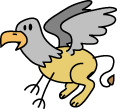
Originally Posted by
T.G. Oskar

Oh, I'll admit - Warshaper is pretty boss, particularly if you had something good to go with it. It's not meant for a primary trick, though; that is, you don't make a build around the Warshaper, but instead use it to enhance a build that relies on shapeshifting. Or at least, that's how I see it - while it has some amazing benefits (+STR/CON, reach, fast healing, immunity to crits and sneak attacks, and of course the extra attack, which could instead allow an existing attack to become more powerful), it was mostly a bunch of solid passive bonuses and one solid source of attack. I could see it on a Cabinet Trickster, though, since between the two you also have the Thought Tricks and whatnot.
However, they're not meant to exist as a class by itself - which is what they did with the PF Shifter. They made an entire class about Wild Shape, but in a way that's all or nothing. It's a cool concept, but not one to fully base a class upon. Now, I'll admit that 5e's Wild Shape is a bit crazy (since it essentially mostly adds your mental attributes to the monster's stat block), but if that's the entire basis for your class, then it's lacking. To put it simply: what would be the subclasses for that class? You could say that you could focus on a specific creature type (one that shifts into Elementals, one that shifts into Celestials, one who shifts into Fiends, etc.), but you'd have to define the basis, and define what other features they get. That's in a way what PF tried to do with their own shapeshfiting class, and it ended up weaker than they thought, because while you had a lot of uses of wildshaping, you'd end up somewhat similar to 3.5's Monk where you became super-dependent on magic items, instead of being the opposite. Sure, you can fly, but only if you turn into a Small creature, which isn't meant for battle.
That's why I said that it's better as a subclass, and as you mentioned - Prestige Classes were the most efficient ways to do so. I could add the Shapeshifter from Oriental Adventures which was a way to grant Wild Shape in a certain way, but they had to be tied to a class first. As it stands, the Path of the Beast for the Barbarian is the closest thing, since while it doesn't grant full shapeshifting (it's more akin to a Dr. Jekyll/Mr. Hyde thing, or even a Bruce Banner/Hulk thing, except both sides are feral instead of one), it still is explicitly fluffed as one. I could see a Barbarian going Bear Warrior, though. In a way, Circle of the Moon Druids also explicitly deal with shapeshifting, in that they improve the shapeshifting abilities of the Druid.
But in short - it's ill-fitting as a class by itself, and there's evidence to it. Bear Warrior was close, but MoMF required previous spellcasting, and Warshaper was only 5 levels long and a buff rather than a build-maker. I could see it as a subclass...and Path of the Beast and Circle of the Moon already deal with that.



 Re: Character Concepts you wished would work in D&D?
Re: Character Concepts you wished would work in D&D?



 Reply With Quote
Reply With Quote